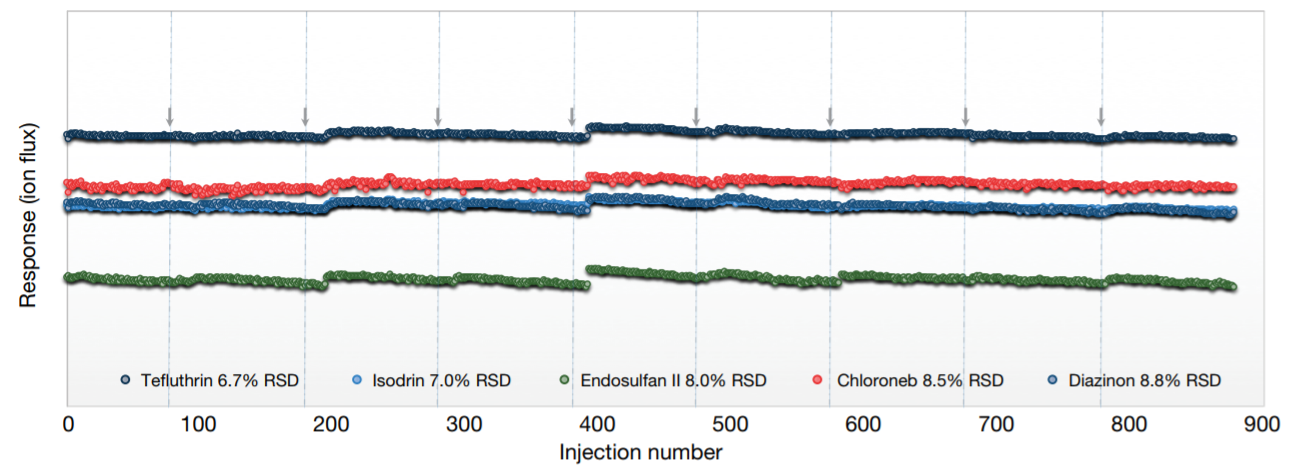Avoiding a Series of Unfortunate Events: Robust Detection of Food Contaminants in Routine Laboratory Environments

Complete the form below to unlock access to ALL audio articles.
Routine food testing workflows are at the front line of food safety, ensuring the products we purchase are free from pesticide residues and other potentially harmful contaminants. These rigorous workflows screen for a vast array of known food contaminants on target lists, handling hundreds of samples every day.
Gas chromatography combined with triple quadrupole mass spectrometry (GC-MS/MS) is widely used for routine food testing applications. Operationally robust, reliable and cost-effective, GC-MS/MS systems are ideally suited to the fast-paced environment of the high-throughput food safety laboratory. What’s more, their exceptional measurement accuracy means they offer confident confirmation of target analytes, even at trace levels.
Improvements in the selectivity of GC-MS/MS systems in recent years have driven down instrument detection limits, enabling the use of quicker, easier and cheaper sample clean-up protocols such as the now widely employed QuEChERS method. However, these sample preparation steps may not remove all components of the matrix, which can make their way into the chromatographic system and the ionization source, triggering a series of challenging events. Detector responses can quickly drop off, leading to quality control failures, higher detection limits, and ultimately the inability to deliver acceptable and regulatory compliant results. Resolving these issues can require a considerable amount of instrument downtime.
In the busy routine food safety environment, instrument downtime can have a serious impact on laboratory productivity and increase workloads and overheads. Ensuring GC-MS/MS systems are sufficiently rugged and robust to deal with – and ideally avoid – these challenges are therefore of great importance.
Enhancing detection limits using innovative ionization source technology
Fortunately, advances in GC-MS/MS systems and workflows are helping food testing laboratories deal with and avoid these challenges. In particular, recent developments in mass spectrometer ionization source technologies are helping to eliminate the costs and disruption caused by unplanned maintenance by increasing instrument tolerance to sample matrices.
Modern systems are based on innovative designs that focus the ion beam more tightly and are robust by design. Advanced electron ionization (AEI) sources provide an exceptional level of measurement sensitivity, pushing detection limits to the attogram range and relieving matrix pressure on the system by reducing the number of sample concentration steps required to meet regulatory limits.
Maximizing sample analysis time with smart tuning tools
Ionization sources become dirty with routine use and GC-MS/MS instruments require regular tuning to ensure consistent performance. Tuning plays a key role in maximizing measurement sensitivity and ensures that the mass calibration is accurate, and the resolution is adequate for the analysis to be performed confidently. However, tuning quadrupole-based mass spectrometers has traditionally been a complex and time-consuming task, requiring specialist technical knowledge and expertise.
Ongoing improvements in instrument control software are helping routine food testing laboratories simplify maintenance workflows and maximize analysis time by making system tuning quicker and easier to perform. Some of the automated calibration tools present within modern GC-MS/MS systems will tune instruments in around 4–5 minutes and provide users with visual indicators of system health. These intuitive interfaces can also provide guidance on the appropriate steps to take, should a particular tuning procedure fail. By reducing the users input on tuning and automating the process; consistent results are produced on the instrument from user to user. This avoids any tuning errors which could lead to batch reanalysis, and ultimately allows food safety laboratories to produce accurate and consistent results in a timely manner.
Pushing the limits of measurement repeatability and instrument robustness
In a recent study designed to test the ruggedness and repeatability of an AEI GC-MS/MS system, baby food samples extracted using the QuEChERS method and spiked with a mixture of pesticides at a concentration of 10 µg/kg per sample were analyzed over approximately 900 repeat injections. This volume of injections equated to a month’s worth of samples for a single GC-MS/MS system in a typical food testing laboratory.
After every 100 sample injections, the instrument’s programmed temperature vaporization liner and injector septum were replaced, the head of the guard column was trimmed by approximately 10 cm, and the MS tuned using the system’s in-built SmartTune feature.
Figure 1 shows the ion flux for five representative pesticide residues, highlighting the very stable response across the entire testing period. Of the 150 pesticides studied, over 90 % resulted in a relative standard deviation of less than 20 % over the full 900 injections. This reproducibility demonstrates the advances in ruggedness and robustness of modern systems for routine food testing applications.

Figure 1. Reproducibility of a GC-MS/MS system over approximately 900 sequential injections of matrix sample extract spiked with pesticide residues at 10 ppb. The arrows indicate injector maintenance and tuning intervals.
Delivering more robust routine GC-MS/MS food testing workflows
Improvements in the design of GC-MS/MS systems are resulting in rugged and robust instruments that are more tolerant to the matrix challenges encountered in food testing workflows. Thanks to advanced ionization source technology and automated instrument tuning tools, the latest GC-MS/MS solutions are helping to minimize and avoid the series of disruptive events typically triggered by the matrix making its way into a system, enhancing instrument uptime and delivering confident results in routine laboratory environments.



